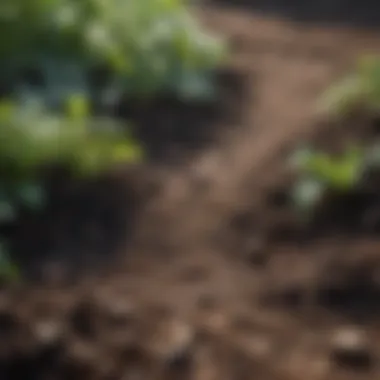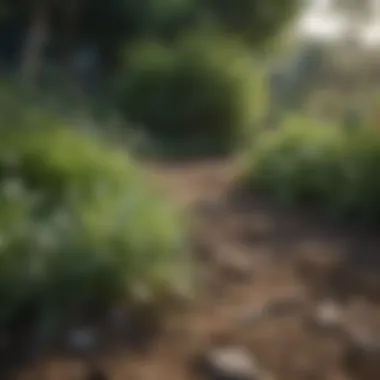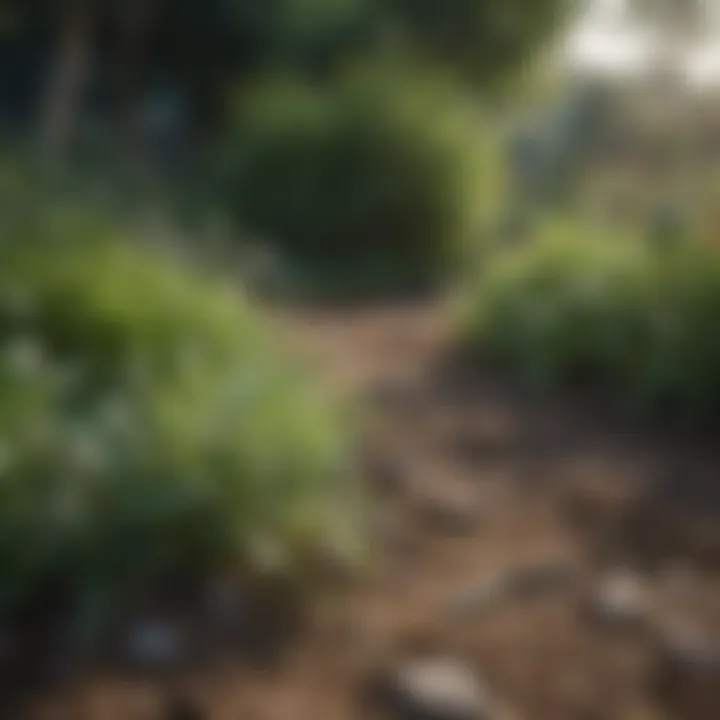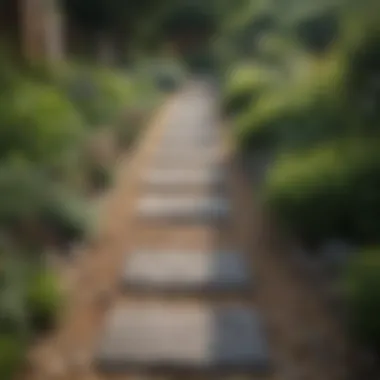Combat Weeds Effectively with Garden Coverings


Intro
Weeds can be a thorn in the side of any gardener. They compete for nutrients, water, and light, ultimately stifling the growth of desired plants. Combatting this issue requires a strategic approach, integrating various methods and materials that not only prevent weeds but also promote a healthier garden ecosystem. This article outlines the effective garden coverings that can minimize weed growth while enhancing the overall gardening experience for homeowners and enthusiasts alike.
Understanding the materials used for garden coverings is essential. Each type has distinct advantages that can cater to specific gardening needs. As sustainability continues to gain importance, exploring innovative solutions helps in implementing best practices that not only benefit gardens but also the environment.
By examining both traditional and contemporary techniques in garden management, readers will find a comprehensive guide aimed at creating thriving outdoor spaces with minimal weed interference.
Effective Garden Coverings
Mulching
Mulching stands out as one of the most effective strategies against weeds. It involves using organic or inorganic materials placed over the soil to prevent weed germination while retaining moisture. Common mulching materials include:
- Wood chips
- Straw
- Bark
- Plastic sheets
- Landscape fabric
Benefits of Mulching:
- Moisture retention: Keeps the soil moisture level stable, reducing the need for frequent watering.
- Soil temperature moderation: Insulates the soil, providing a more conducive environment for plant growth.
- Weed suppression: Acts as a barrier, significantly reducing light exposure to weed seeds.
Ground Covers
Ground covers are low-growing plants that fill in spaces in gardens. They suppress weeds while adding aesthetic value to the landscape. Some popular ground cover plants include:
- Clover
- Creeping thyme
- Vinca minor
- Ajuga
Advantages of Ground Covers:
- Aesthetic appeal: They create a lush look and can support pollinators.
- Reduced maintenance: Once established, they require less care compared to other plants.
Landscape Fabrics
Landscape fabric is a woven material that blocks weed growth while allowing air and water to penetrate. Its durability and effectiveness make it a popular choice in established gardens.
"Using landscape fabric can greatly minimize manual weeding, providing more time to enjoy the garden."
Key Features of Landscape Fabrics:
- Long-lasting: Typically made from synthetic materials, ensuring durability.
- Versatile: Can be used under mulches, gravel, or stone.
Other Effective Solutions
Combating weeds doesn't end with mulches and ground covers. Other materials can provide additional support in weed management:
- Coconut coir: An eco-friendly alternative that breaks down slowly, enriching the soil.
- Cardboard or newspaper: Simple and effective, these biodegradable options smother existing weeds and decompose over time.
By integrating these coverings into a gardening plan, the struggle against weeds becomes more straightforward and efficient.
Prelude to Garden Coverings
Garden coverings play a pivotal role in effective weed management. They serve as a barrier between the soil and the multitude of weed species that can invade a garden space. With weed growth often leading to reduced agricultural productivity and the unappealing appearance of green spaces, understanding the various garden covering strategies can significantly enhance the aesthetic and functional aspects of a garden.
Weeds compete with plants for vital resources like water, light, and nutrients. They can hinder the growth and health of desired crops. Thus, controlling weeds is not merely about having a neat garden; it's fundamentally about ensuring that plants can thrive.
Additionally, garden coverings can provide other advantages beyond weed control. They can help maintain adequate moisture levels in the soil, reduce the need for aggressive herbicide use, and promote healthy microbial activity in the soil. These benefits make an understanding of garden coverings crucial for any serious gardener or landscaping enthusiast.
The Importance of Weed Control


Effective weed control is essential for the success of any garden. Weeds can quickly overtake garden beds, leading to choking out of flowers and vegetables. This competition not only stunts plant growth but also requires more frequent maintenance and resources to remove them.
Furthermore, uncontrolled weed growth can lead to increased pest populations. Weeds can host pests and diseases that may spread to nearby plants. Thus, maintaining a weed-free environment is a preventive measure that contributes to the overall health of the garden ecosystem.
Using garden coverings can minimize the need for manual weeding, which is time-consuming and labor-intensive. By suffocating weed seeds or preventing sunlight from reaching them, these materials can significantly reduce the time and effort needed to maintain a garden, allowing gardeners to focus on promoting growth and health.
Overview of Garden Covering Materials
There are various materials used for garden coverings, each with its own set of strengths and weaknesses. These include organic types, synthetic fabrics, plastic sheeting, and even biodegradable options like cardboard and newspaper. Understanding these materials helps in making informed decisions that align with the unique conditions of a specific garden.
Organic Mulch: Typically derived from natural sources, such as wood chips, straw, or leaves, organic mulches decompose over time. They enrich the soil while providing a physical barrier against weeds.
Synthetic Fabrics: These textiles are designed specifically for weed prevention and can be reused for multiple seasons. They allow water and air to pass through, preventing weeds without disrupting soil health.
Plastic Sheeting: Widely used for crop production, plastic sheeting can be very effective for controlling weeds but requires careful application to avoid issues like soil overheating.
Cardboard and Newspaper: These materials offer a more sustainable approach, as they break down over time and can suppress weeds while improving soil quality. They are particularly appealing for environmentally-conscious gardeners.
Selecting the proper garden covering material depends on various factors such as soil type, climate, and the specific plants being cultivated. A thorough assessment is necessary to ensure the chosen covering aligns with the garden's needs.
Types of Garden Coverings
Garden coverings play a significant role in maintaining the overall health of a garden. Their primary purpose is to prevent weed growth, which can compete with plants for nutrients, light, and water. Selecting the right type of garden covering is essential for the success of any gardening project. Different materials offer various benefits and challenges, and this section provides a detailed exploration of those options.
Organic Mulch
Types of Organic Mulch
Organic mulch includes a variety of materials such as bark, straw, grass clippings, and wood chips. Each type has its own characteristics and benefits. For instance, bark mulch breaks down slowly, providing long-term weed suppression while improving soil structure as it decomposes. Straw is lightweight and easy to spread, making it a popular choice for gardeners looking for an effective but manageable option. Grass clippings, on the other hand, decompose quickly but can become compacted and matted, which may hinder air movement to the soil.
Organic mulch is a favored choice because it adds organic matter to the soil, enriching its structure and fertility over time. However, some mulches have a shorter lifespan, necessitating frequent replacement, which can be a consideration for garden maintenance.
Benefits of Organic Mulch
Utilizing organic mulch provides numerous benefits to gardens. It effectively suppresses weed growth by blocking sunlight, preventing weed seeds from germinating. Additionally, organic mulch contributes to soil moisture retention, reducing the need for frequent watering. It improves soil temperature regulation, keeping roots cooler in the summer heat and warmer during cooler months.
Another critical advantage is that as organic materials break down, they release nutrients into the soil, supporting the overall health of plants. However, it does require periodic replenishment, as it decomposes over time, which could be seen as a downside for some garden enthusiasts.
Synthetic Fabrics
Common Types of Synthetic Fabrics
Synthetic fabrics like landscape fabrics and geotextiles are engineered specifically for weed control. They are designed to allow water and nutrients to pass through while blocking sunlight. This is why they are effective in preventing weed growth. Landscape fabric is made of woven polypropylene, providing durability and strength. Geotextiles, used in more extensive landscape projects, offer similar benefits but are often heavier and more robust.
Many gardeners appreciate these fabrics for their longevity and effectiveness, as they last for several years without significant degradation. However, synthetic fabrics can be more expensive than traditional mulches, and their installation requires careful handling to avoid overlapping or improper positioning.
Advantages of Synthetic Fabrics
The key advantage of synthetic fabrics lies in their durability and effectiveness. They can suppress weeds for several growing seasons with minimal maintenance. Additionally, synthetic options may not require the frequent applications that organic mulches do. This can lead to cost savings in the long-term, as they do not need regular replacement.
Nevertheless, one must consider that synthetic fabrics can sometimes hold heat and moisture excessively, which could create a less-than-ideal environment for some plants. Proper installation is vital to mitigate these issues.
Plastic Sheeting
Types of Plastic Sheeting
Plastic sheeting comes in various thicknesses and types. Some common options include polyethylene and PVC. Each type serves different gardening needs. For example, thicker polyethylene sheeting is often used in commercial agriculture for its durability and effectiveness in preventing weed growth while permitting air and moisture exchange.
Another option, black plastic, is popular among home gardeners due to its cost-effectiveness and availability. However, while it effectively suppresses weeds, it may also heat the soil, which can be advantageous or disadvantageous depending on the climatic conditions.


Correct Application Techniques
Applying plastic sheeting requires careful attention. It's essential to lay down the sheeting evenly, ensuring there are no gaps. Overlapping seams can allow weeds to break through. Secure edges using soil or landscape staples to prevent lifting and blowing during windy conditions. Moreover, it is vital to monitor for drainage; proper drainage holes should be made where necessary, as standing water can lead to root rot in nearby plants.
Feedback from experienced gardeners suggests that when used correctly, plastic sheeting can be a potent tool in weed management, but it does involve a bit of technique and understanding of local climate conditions.
Cardboard and Newspaper
Effectiveness of Paper Barriers
Using cardboard and newspapers as weed barriers is an increasingly popular method among eco-conscious gardeners. Both materials effectively block light, preventing weeds from germinating beneath. Cardboard, especially when layered, tends to offer better weed suppression than newspaper. Moreover, both options are biodegradable, making them an environmentally friendly choice.
This method is particularly effective in vegetable gardens and around perennial plants where the aim is to create a sustainable growing environment. However, it is essential to avoid using glossy paper or ink that could introduce chemicals into the soil.
Environmental Considerations
One of the main appeals of cardboard and newspaper lies in their low environmental impact. These materials can be easily sourced and recycled, which aligns well with sustainable gardening practices. As they decompose, they enrich the soil and enhance its structure.
However, the effectiveness can diminish over time as they break down, necessitating consistent monitoring and potential layering for continued coverage. It's a viable option for those wishing to minimize their carbon footprint in gardening.
Implementing Garden Coverings
Implementing garden coverings effectively is essential for maintaining healthy and productive garden spaces. This practice involves selecting suitable materials and applying them correctly to suppress weeds and enhance soil conditions. A well-implemented garden covering strategy can result in reduced maintenance efforts and healthier plants overall.
Choosing the Right Material
Choosing the right material is a crucial step. Different materials offer various benefits and limitations, making it vital to consider their compatibility with your garden's environment.
Assessing Soil Type
Assessing soil type serves a significant role in determining the most effective garden covering material. Different soils have varying drainage capabilities, nutrient contents, and moisture retention levels. For instance, sandy soils drain effectively but may require more frequent watering. In contrast, clay soils hold water longer but may need improved drainage methods.
A key characteristic of soil type assessment is the ability to match the garden covering material with the soil's natural properties. For example, organic mulch can improve soil structure in clay areas while also suppressing weeds. The unique feature of soil type analysis is its ability to guide gardeners in choosing the most effective covering, thus contributing to better plant growth and lower weed competition.
Understanding Plant Needs
Understanding plant needs involves a thorough evaluation of what the specific plants in your garden require for healthy growth. Factors such as light exposure, moisture levels, and nutrient requirements vary across plant species. This information is crucial when selecting a garden covering.
A major factor that highlights understanding plant needs is the alignment of garden coverings with plant growth stages. For instance, some young plants might require more light and air, making lightweight covers more suitable. Conversely, established plants may benefit from robust mulch that provides more moisture retention. This unique feature of plant needs assessment ensures the selected covering supports the intended flora while efficiently combating weeds.
Application Methods
Application methods are equally vital to the success of garden coverings, determining how well these materials work once in place. Effective application can maximize the benefits and minimize potential drawbacks.
Layering Techniques
Layering techniques involve applying garden coverings in specific arrangements that optimize their benefits. For example, a combination of newspaper followed by organic mulch can create a highly effective barrier against weed growth. This method takes advantage of different materials' properties, enhancing overall effectiveness.
A preferred characteristic of layering techniques is their adaptability to various garden styles and types. Whether dealing with flower beds or vegetable patches, layering can be customized to suit specific needs. Its unique feature includes the promotion of soil health as each layer works together to create a conducive environment for plants while deterring weeds efficiently.
Maintenance Guidelines
Maintenance guidelines play a pivotal role in ensuring that garden coverings remain effective over time. Regular checks for breakdown, shifting, or growth of weeds are necessary to maintain the barrier function of the covering material. Timely replenishment of organic matter and appropriate adjustments also contribute to sustained success.
An essential characteristic of maintenance guidelines is their focus on ongoing care. Covering materials may require periodic upkeep to function as intended. The unique aspect of these guidelines entails a proactive approach that fosters a healthy garden ecosystem over time, thus ensuring long-term weed suppression and optimal plant growth.
Consistent maintenance is crucial for the prolonged success of any garden covering strategy.
Advantages of Using Garden Coverings


Garden coverings provide various advantages that enhance the overall health of a garden. They serve as barriers against weeds, protect soil structure, and improve growing conditions for plants. In this section, we will explore several key benefits of garden coverings: weed suppression, soil moisture retention, and soil temperature regulation. Understanding these advantages is essential for any gardener aiming to create a more efficient and productive gardening space.
Weed Suppression
Weed control is a primary function of garden coverings. By blocking sunlight, these materials hinder weed growth effectively. Weeds often compete with desirable plants for vital resources like light, water, and nutrients. Therefore, using garden coverings can lead to better yields and healthier plants.
Different types of coverings can suppress weeds. Organic mulches, such as straw or wood chips, decompose over time, enriching the soil while simultaneously preventing weeds. Synthetic fabrics, like landscape fabric, provide a long-lasting solution as they allow air and water to penetrate but restrict weed growth.
"Effective weed suppression leads to healthier gardens and reduces the need for chemical herbicides."
By adopting these coverings, gardeners can significantly lower their weed problem, thus minimizing the time and effort spent on manual weeding, which may otherwise interfere with gardening schedules.
Soil Moisture Retention
Another important advantage of using garden coverings is their ability to retain soil moisture. Coverings can prevent water from evaporating, maintaining consistent moisture levels in the soil. This is especially beneficial during drier months when plants need a steady water supply to thrive.
Organic mulches help by creating a barrier that traps moisture below. They break down to add nutrients, improving the soil structure. On the other hand, synthetic coverings protect against rapid moisture loss while allowing for good air circulation, ensuring plants receive necessary hydration without waterlogging the soil.
This moisture retention aids in reducing irrigation frequency, proving to be cost-effective and environmentally friendly. The less water needed means better resource management and a reduced water bill for homeowners.
Soil Temperature Regulation
Garden coverings also play a critical role in regulating soil temperature. They act as insulators during extreme temperatures, keeping the soil warmer during colder months and cooler during hotter spells.
For instance, organic mulches warm the soil in spring, promoting earlier germination and plant growth. Conversely, in summer, they keep the soil cool, protecting roots from heat stress. This temperature regulation maximizes plant health and growth potential.
For gardeners, the choice of covering becomes strategic based on seasonal needs. An understanding of temperature regulation will lead to a more effective gardening plan, ensuring crops are planted at optimal times for growth.
In summary, advantages such as weed suppression, soil moisture retention, and soil temperature regulation highlight the importance of garden coverings. Proper implementation of these materials can lead to significant improvements in gardens, making it a wise investment for any gardening enthusiast.
Environmental Considerations
Understanding environmental considerations in gardening is crucial for fostering a more sustainable landscape. Garden coverings have a direct impact on the ecosystem, helping to mitigate weed growth while supporting the health of the soil and surrounding flora.
Sustainable Practices
Implementing sustainable practices is essential for preserving our environment. It involves using methods that meet current gardening needs without compromising future generations. One significant aspect of sustainable practices in garden coverings is the choice of materials used.
Biodegradable Options
Biodegradable options include materials that decompose naturally over time. These coverings, such as straw, grass clippings, or shredded leaves, contribute to the soil's health as they break down. The key characteristic of biodegradable options is their ability to nourish the soil, which is a beneficial aspect. As these materials decompose, they add organic matter, enhancing soil structure and fertility.
However, there are drawbacks. Biodegradable options may require more frequent replacement than synthetic materials. For example, straw may break down within a single season, necessitating another layer. Nonetheless, their environmental benefits often outweigh the need for more frequent updates, making them a valuable choice.
Recycling and Reusing Materials
Recycling and reusing materials is another vital sustainable practice. By utilizing materials like old carpet, cardboard, or even used plastic sheeting from other projects, gardeners can reduce waste. This practice directly contributes to minimizing landfill contributions and lowers the demand for new materials. The key characteristic of this option is its resourcefulness.
A unique feature of recycling and reusing materials is that it encourages creativity in gardening. Homeowners often find innovative solutions that fit their personal style while being environmentally friendly. However, some materials may degrade in sunlight or become less effective at suppressing weeds over time. Despite these limitations, the advantages of an eco-conscious approach are significant, as it fosters a sustainable gardening practice.
Impact on Local Ecosystems
Garden coverings not only influence individual gardens but also affect local ecosystems. The use of certain materials can harm or benefit local wildlife. For example, plastic coverings may create a barrier for small animals, while organic options support local insect populations by providing habitats.
Overall, considering the environmental implications of your garden coverings ensures healthier gardening practices, benefitting both your immediate space and the broader ecosystem.
End
The conclusion of this article emphasizes the critical role that effective garden coverings play in combating weeds. By using appropriate materials, gardeners can significantly reduce the proliferation of unwanted plants that compete for nutrients and space. The benefits of employing garden coverings extend beyond mere weed suppression, as they also contribute to soil health and promote effective moisture retention.
Recap of Key Points
- Various Types of Garden Coverings: Understanding different materials like organic mulch, synthetic fabrics, and simple paper barriers is essential. Each option has unique advantages that cater to specific gardening needs.
- Weed Suppression Techniques: Proper implementation of garden coverings reduces weed growth significantly, saving time and effort in garden maintenance.
- Environmental Impact: Thoughtful selection of coverings not only aids in gardening but also supports sustainable practices, impacting local ecosystems positively.
"A well-maintained garden is not solely defined by the absence of weeds but by the health of the soil and plants as well."



